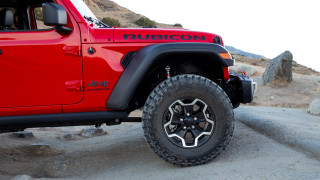Is the Jeep Gladiator AWD?
Oh you bet it is. Part-time four-wheel drive comes standard on all models, with a full-time four-wheel drive system now optional on all trim levels. The Rubicon gets its own rock-crawling oriented four-wheel drive system standard with a two-speed transfer case and a 4.0:1 low-range gear ratio.
How fast is the Jeep Gladiator?
The Gladiator isn’t built for speed, it’s built to perform off-road and that’s a job it does with delight. It is really more at home in dirt or mud than on pavement, and that focus on one aspect of performance while putting on-road comfort on the backburner nets a middling performance rating.
The standard engine is a 285 hp, 3.6-liter V-6 that makes 260 lb-ft of torque. A 6-speed manual transmission is standard for all Gladiator models, with an 8-speed automatic available as a $2,000 option on all trims. The important addition for 2021 is a new 3.0-liter turbodiesel V-6 that makes 260 hp and 442 lb-ft of torque and is only available with its own 8-speed transmission. That does make the addition of the turbodiesel an expensive proposition, the automatic costs $2,000 and then the engine itself another $4,000.
Even with the improved fuel economy, that price gap doesn’t make the turbodiesel an economical proposition but it does improve performance in some key areas. All of that torque pours on at just 1,400 rpm and that gives the Gladiator some added quickness on the road. Off-road, the engine shines even more. Jeep did a great job tuning the Gladiator’s throttle response with that engine, it’s easy to find the exact amount of power you need to get over an obstacle and the additional torque means that in sand, it easily keeps the wheels churning through the soft stuff to maintain momentum. It’s a bit noisier, but a good trade-off for the bump up in performance.
The Gladiator’s added length improves its highway ride over the Wrangler, but not by too much. Stretching out the wheelbase makes it a bit more stable, but still has a tendency to float at speed and you’ll be making frequent small steering corrections. Competitors in this class, especially the Honda Ridgeline, are more composed for day-to-day drive driving.

Though each of the Gladiator’s trims are at worst good off-road, the Mojave and the Rubicon take things to the next level. The Mojave is set up for sand running, with added ground clearance, Fox internal bypass shocks, and 33-inch all-terrain tires. The Rubicon takes things slower, with a more robust transfer case, Fox monotube shocks, automatic sway bar disconnects, and locking front/rear differentials, mechanical additions that enhance its rock crawling abilities. Both trucks excel at their given roles, giving the Gladiator the best capability in this class in both scenarios.
Tow rating maxes out at 7,650 pounds with the Sport trim level and the trailering package added, along with the 8-speed automatic. Other trim levels tow between 4,000 and 7,000 pounds, with the higher figures coming with the automatic transmission. Payload ratings range from 1,075 to 1,700 pounds, so if loading up the bed or towing are important to you then picking the right trim/powertrain combination will be important.
Review continues below